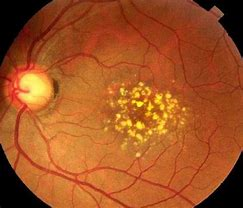Focus On: Macular Degeneration
- Cooper & Leatherbarrow

- Jul 1, 2018
- 2 min read
Macular degeneration (often referred to as Age-related Macular Degeneration; AMD) happens when the back of your eye becomes damaged. This can make it harder to see fine detail, such as recognising faces, or to read or watch television. However, this does not normally affect your ability to walk around as the edge of your vision should not be affected.
The most common forms of AMD occur as your get older. Around 1 in 10 people over the age of 65 will show some signs of it. Symptoms can vary.
Some people simply notice that things appear blurry or that they have difficulty reading, even with their normal reading glasses. Other people may notice that they have a smudge in their central vision which does not go away, or they may notice that straight lines are distorted or wavy.
“Around 1 in 10 people over the age of 65 will show some signs of it”
Some people with AMD may notice that they become sensitive to bright light, or that they find it difficult to adapt when going from a dark to light environments. Colours may also be seen to be faded.

AMD can be classified as early or late. Early AMD is always ‘dry AMD’. This is when yellow deposits, know as drusen, build up behind the macula.
Most people with early AMD have near normal vision. There is no treatment for early AMD. A minority of people with early AMD will progress to late AMD. Late AMD may be ‘wet’ or ‘dry’. Wet AMD occurs when the abnormal blood vessels begin to grow behind the macula and leak fluid. This pushes the macula away from its blood supply at the back of the eye and causes a rapid loss of vision.
It is usually associated with you noticing distorted vision (straight lines become wavy, or you have a smudge or blank spot in the centre of your vision. Late dry AMD is called ‘geographic atrophy’ and is rarer than late wet AMD. This is where vision is lost because the retina thins but there are no leaking blood vessels.
There is currently no treatment for dry AMD.

Wet AMD can often be treated if it is caught early enough. This is normally done by injecting a drug into the gel inside the eye. This shrinks the new blood vessels that are pushing the macula away from the back of the eye. This is often repeated several times and is provided on the NHS.
It is important that changes are spotted early by checking your vision in each eye separately and contacting your optometrist immediately if your vision suddenly becomes distorted or you have a blank spot in your vision.
A special scan called an OCT (now available at both Darlington and Horden practices) can take a detailed look at your maculae to check for signs of AMD.
If you have any concerns about AMD, do not hesitate to contact your nearest Cooper & Leatherbarrow practice.




Comments